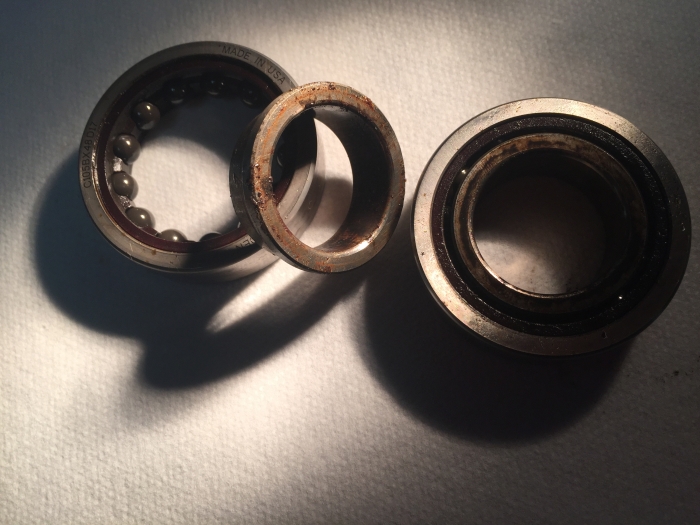Article from GTI Spindle Technology Inc.
While this statement may not applicable across the board with machine tool applications, it certainly rings true when used in context with air supply to machine tool spindles. More often than not we have found that poor quality air supply to spindles is a significant factor in premature machine tool spindle failures. Whether it be a dirty (particulate contaminant) in the air supply or more predominantly moisture contaminated air supply. This is a recipe for disaster.
Too often, maintenance personnel and operators alike focus primarily on proper lubrication supply to spindles. While this is extremely important as it can cause immediate spindle failure if not properly configured, a contaminated air supply is what we refer to as the “silent killer” of spindles.

Contaminated/failed bearings as a result on non dry-contaminated air supply. Photo courtesy of GTI Spindle Technology
It is an industry fact that 80 percent of all spindles fail due to contamination. Often times the assumption is made that it is contamination caused by ingress from an external source, i.e. grinding swarf or part coolant. You would be surprised to learn that you (the end user) are in many cases slowly but surely killing your own spindle, which is your production lifeline.
The following is a case in point. A large, well-known and experienced Pennsylvania-based auto parts manufacturer routinely runs 24/7 production utilizing Bryant high-speed ID grinding spindles. In 2016, the company's spindle failure rates were averaging 40 repairs per year with contamination failures representing 80 percent of those failures. We worked closely with the end user to track and trend these failures not only by spindle s/n but most importantly by machine tool s/n that the spindle were deployed in.
After diligent team work and route cause of failure assessments and machine tool assessments, today the spindle failure rates have dropped by nearly 50 percent. Why and how you ask? It’s simple in this case … drier is better.
The company purchased and installed a three-cell dryer. It’s overall capacity is 7,500 cfm (2,500/cell), so that the manufacturer only ever need to be running on two cells at a given time. The advantage to the three-cell dryer is that one cell can be maintained without stopping production.
By cooperative identification of “problem” machines and subsequent implementation of the air drier system to support the machine tools, spindle contamination failures have dropped dramatically.
GTI Spindle Technology recognizes that in today’s manufacturing world, machine uptime is one of the most critical objectives production facilities face. This said, it is incumbent upon service providers to not only provide the fastest lead times possible but, as importantly if not more importantly, working with manufacturers to identify issues, assist in corrective actions and optimize their spindle usage and support systems to prevent unnecessary machine tool downtime.
Related Glossary Terms
- coolant
coolant
Fluid that reduces temperature buildup at the tool/workpiece interface during machining. Normally takes the form of a liquid such as soluble or chemical mixtures (semisynthetic, synthetic) but can be pressurized air or other gas. Because of water’s ability to absorb great quantities of heat, it is widely used as a coolant and vehicle for various cutting compounds, with the water-to-compound ratio varying with the machining task. See cutting fluid; semisynthetic cutting fluid; soluble-oil cutting fluid; synthetic cutting fluid.
- grinding
grinding
Machining operation in which material is removed from the workpiece by a powered abrasive wheel, stone, belt, paste, sheet, compound, slurry, etc. Takes various forms: surface grinding (creates flat and/or squared surfaces); cylindrical grinding (for external cylindrical and tapered shapes, fillets, undercuts, etc.); centerless grinding; chamfering; thread and form grinding; tool and cutter grinding; offhand grinding; lapping and polishing (grinding with extremely fine grits to create ultrasmooth surfaces); honing; and disc grinding.
- inner diameter ( ID)
inner diameter ( ID)
Dimension that defines the inside diameter of a cavity or hole. See OD, outer diameter.
- swarf
swarf
Metal fines and grinding wheel particles generated during grinding.
